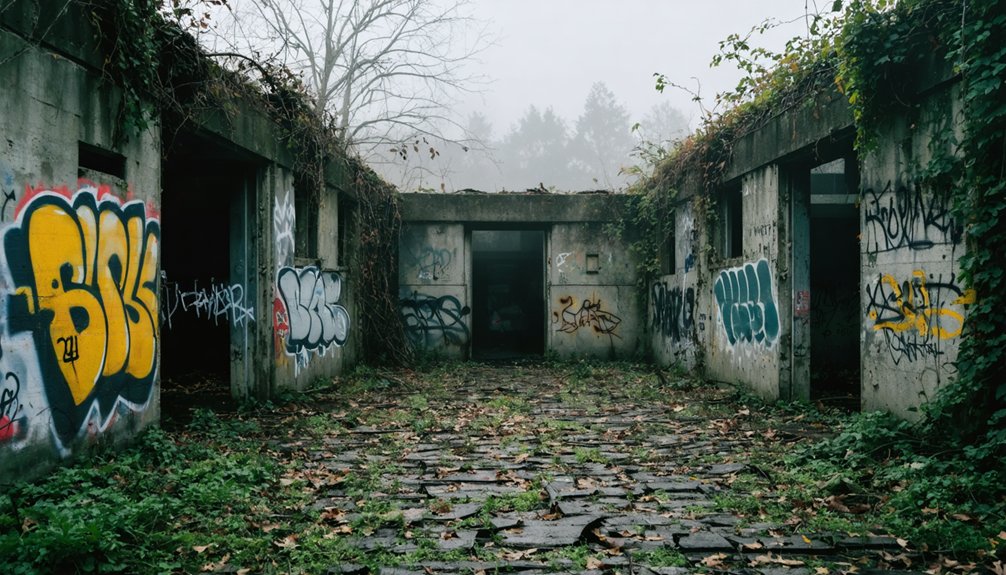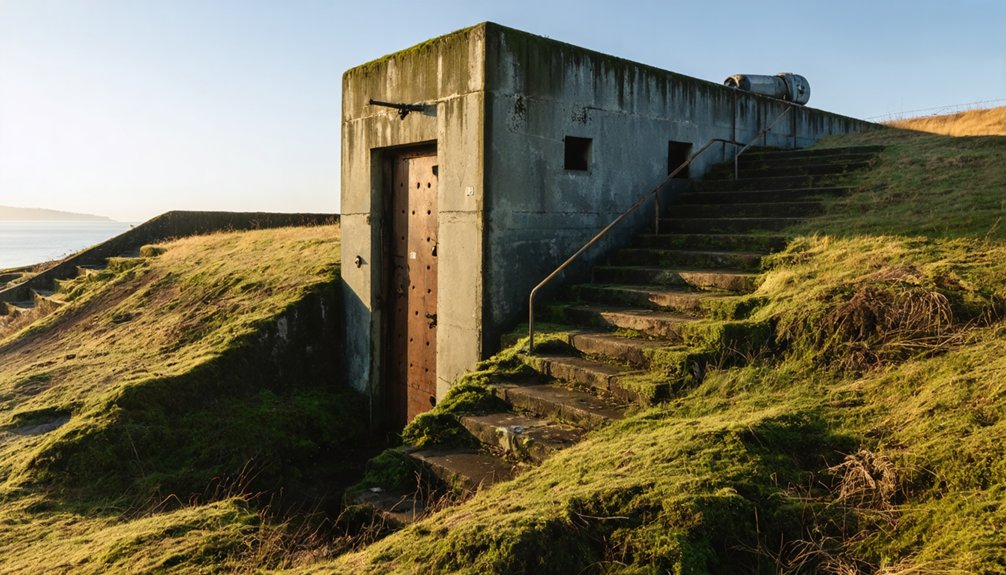When exploring abandoned US military bases, you’ll discover everything from massive naval stations like Roosevelt Roads to underground Titan I missile complexes. These sites offer glimpses into Cold War history but come with serious hazards—groundwater contamination, structural dangers, and toxic substances. You’ll need proper research and safety equipment before visiting these decaying monuments. The fascinating architectural remnants and strategic stories behind these military ghost towns reveal America’s evolving defense priorities.
Key Takeaways
- Abandoned military installations like Roosevelt Roads Naval Station and Titan I Missile Complexes offer glimpses into America’s Cold War history.
- Urban explorers face legal restrictions, structural hazards, and environmental dangers including asbestos and chemical contamination.
- Many former bases contain environmental hazards with PFAS, TCE, and benzene exceeding state and federal safety standards.
- Base closures through BRAC commissions (1988-2005) led to over 350 abandoned installations across the United States.
- Former military sites often feature distinctive architectural styles reflecting their era, with approximately 20% of original structures remaining.
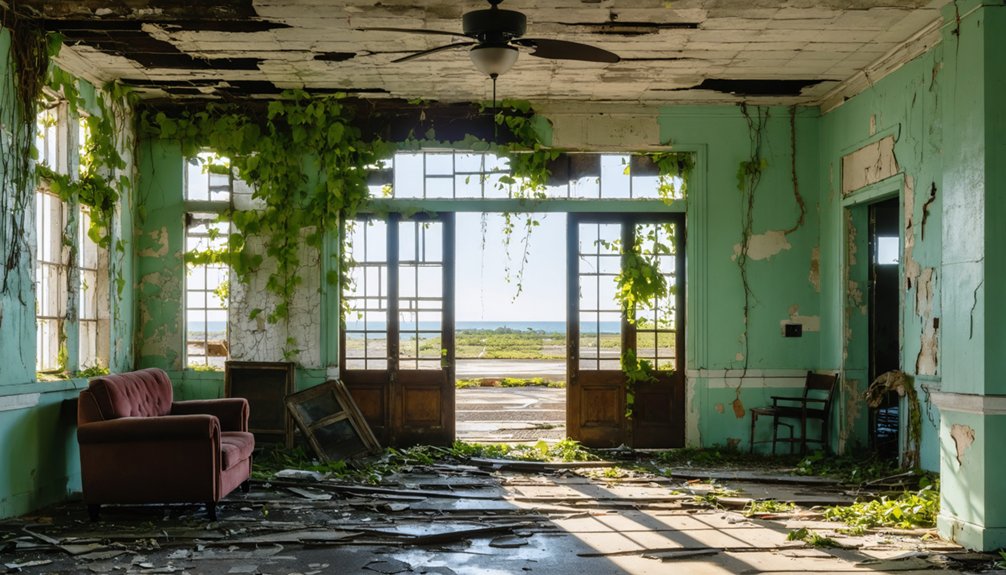
Spanning 8,650 acres of Puerto Rican coastline, Roosevelt Roads Naval Station represents one of the most extensive abandoned military complexes in U.S. territorial history.
Roosevelt Roads: 8,650 acres of abandoned military history etched into Puerto Rico’s coastline.
What began as FDR’s 1919 vision materialized into a $72 million strategic Caribbean outpost that evolved from WWII operations hub to Cold War naval station.
You’ll encounter an 11,000-foot runway and deep-water port facilities now largely reclaimed by nature, evoking powerful military nostalgia.
The base’s 2004 closure—precipitated by controversial Vieques bombing exercises—created a paradoxical vacuum: political victory paired with devastating economic implications for local communities.
While limited military operations resumed by 2025, most infrastructure remains dormant.
The ghost town’s abandoned housing units, hospital, and deteriorating facilities stand as evidence to shifting geopolitical priorities and the complex relationship between military presence and territorial autonomy.
Hurricane Maria in 2017 prompted the establishment of a significant Installation Staging Base for relief efforts, marking the first major military activity at the site since its 2004 closure.
The site’s transition to the José Aponte de la Torre Airport represents a significant shift from military operations to civilian commercial services in Puerto Rico.
Fortuna Air Force Station: Cold War Radar Ruins in North Dakota
High atop the windswept plains of North Dakota, Fortuna Air Force Station emerged as a critical Cold War sentinel in April 1952.
You’ll find its Fortuna history dominated by the 780th Aircraft Control and Warning Squadron’s vigilance against Soviet bomber incursions.
The station’s radar technology evolved dramatically—from basic AN/FPS-3 search systems to the advanced FPS-35 antenna that withstood North Dakota’s brutal elements.
By 1961, Fortuna integrated into the SAGE network, later becoming a BUIC III site with sophisticated computerized defenses. The transition required installation of the massive FST-2 data transmitter that contained over 6900 vacuum tubes demanding extensive cooling systems.
Standing on its 124-acre footprint near the Canadian border, you’d once have seen 118 buildings supporting 150 personnel. The site featured a complete community with 45 family houses and recreational facilities to support military families in this isolated location.
Today, only cell antennas remain where the imposing five-story radar tower once scanned northern skies, a rusting symbol of America’s Cold War defensive perimeter.
The Base That Never Was: Bong Air Force Base’s Abrupt Abandonment
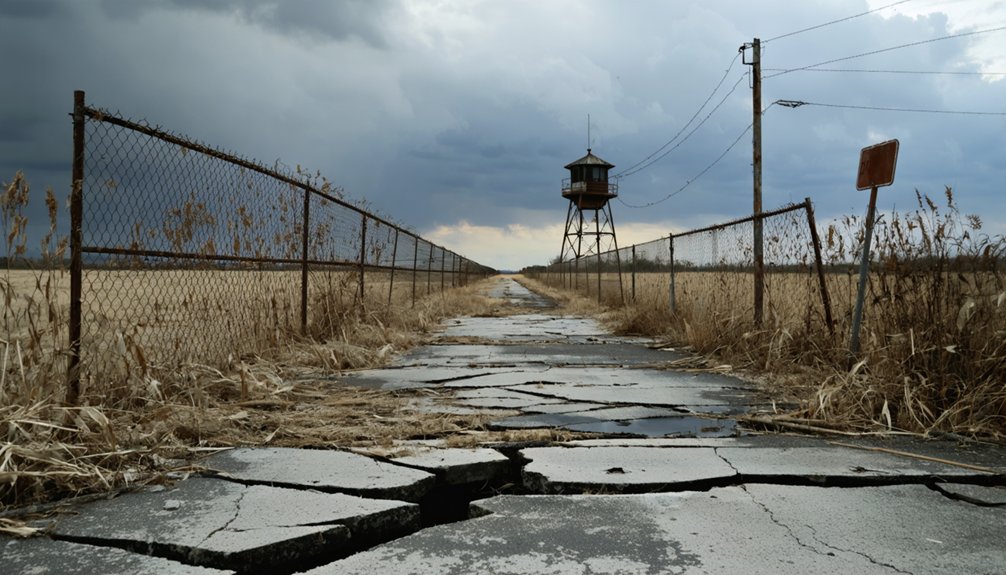
While Cold War tensions escalated in the mid-1950s, the U.S. Air Force initiated an ambitious $83 million installation near Kansasville, Wisconsin. Named after WWII ace Richard Bong, this strategic facility was positioned to defend Milwaukee and Chicago from Soviet bomber threats.
The military acquired 5,400 acres of farmland, displacing over 70 families as crews worked relentlessly on site preparation. Critics and skeptics increasingly questioned the project’s viability, labeling it a potential white elephant. Costs ballooned after the project’s integration with Strategic Air Command, ultimately exceeding $29 million before completion. The project’s original budget approval from the House of Representatives in June 1955 was only $16 million.
In a stunning display of Military Abandonment, officials halted construction just days before pouring the 12,500-foot runway’s concrete. The Bong Base project, one of America’s most ill-fated military installations, was terminated after four years of development, leaving partially completed infrastructure abandoned until Wisconsin repurposed the land for recreation.
Underground Secrets: Exploring Titan I Missile Complex Remnants
You’ll encounter vast underground labyrinths when examining abandoned Titan I missile complexes, with their 160-foot-deep silos and 9-foot-diameter tunnel systems that once housed America’s first generation of ICBMs.
These Cold War relics feature interconnected chambers including missile silos, antenna facilities, and command bunkers that demonstrate remarkable engineering achievements of their era.
Potential explorers must recognize significant contamination hazards from residual fuels and chemicals, as these sites housed highly volatile liquid oxygen and refined kerosene propellants that weren’t fully remediated after decommissioning.
The complete launch sequence for these technological marvels required approximately 15 minutes from initiation to missile departure, highlighting the rapid response capabilities that were essential during the nuclear standoff.
The Titan I missile was designed with an impressive 3.75 MT warhead capable of delivering devastating nuclear strikes against Soviet targets during the height of Cold War tensions.
Cavernous Cold War Relics
Beneath the rolling plains of the American West lie some of the most impressive Cold War relics ever constructed: the massive Titan I missile complexes.
You’ll find these engineering marvels spread across five western states, each representing the pinnacle of 1960s Military Architecture.
When you explore these cavernous structures, you’re walking through America’s first line of nuclear defense. Each complex housed nine 98-foot ICBMs in triple-silo configurations, connected by extensive tunnel networks with blast-proof doors designed to prevent simultaneous opening.
The Cold War engineering included control centers, powerhouses, and specialized antenna silos—all built to withstand nearby nuclear blasts. These facilities stored the first multistage ICBMs that utilized liquid oxygen and RP-1 as propellants in the U.S. arsenal.
One such facility in Lincoln, California is now facing environmental contamination issues with trichloroethene found in surrounding soil and groundwater.
Though deactivated by 1965 and mostly sold to private owners, these underground labyrinths remain as silent testimonies to an era when freedom hung in the balance.
Contamination Risks Below
Although these underground monoliths stand as remarkable Cold War monuments, they harbor serious environmental hazards that require careful consideration before exploration.
Extensive health assessments reveal multiple contamination sources that persist decades after decommissioning:
- Groundwater contains TCE and PCE cleaning solvents with plumes extending beyond site boundaries.
- Soil samples show petroleum chemicals and PCBs from electrical equipment.
- Elevated metals (zinc, cadmium) exist from structural corrosion.
- Trace benzene in Launch Control Centers presents slight cancer risks.
While no radioactive contamination exists, these chemicals exceed state and federal standards in localized areas.
You’ll encounter restricted access at these sites—not just for security, but because ongoing remediation efforts will continue for decades.
Freedom to explore comes with responsibility to recognize these persistent environmental legacies.
Toxic Legacy: Health and Environmental Hazards at Deserted Military Sites

When military forces vacate their bases, they often leave behind a dangerous cocktail of chemicals that persist long after the last personnel have departed. PFAS from firefighting foam, TCE, benzene, and radioactive materials contaminate soil and groundwater for decades, creating environmental justice concerns for surrounding communities.
You’ll find these abandoned installations often become Superfund sites, with cleanup costs reaching tens of millions per location. Residents near these toxic sites face disproportionate health disparities, including increased cancer rates, thyroid disease, and immune disorders.
The contamination creates a deadly legacy at places like George Air Force Base and Fort Ord. Community advocacy has become essential as the Department of Defense’s remediation efforts remain inadequate, with many sites receiving minimal cleanup.
The military’s toxic footprint leaves communities fighting for recognition while contamination silently persists across abandoned bases.
The toxic exposure continues to threaten local water supplies and ecosystems decades after military departure.
Architectural Remnants: Distinctive Features of Abandoned Military Infrastructure
Military installations across America boast distinctive architectural identities that persist long after abandonment, representing both historical military design philosophies and practical engineering solutions.
These forgotten structures showcase a rich architectural heritage that reveals our military past through their unique design aesthetics.
When exploring these sites, you’ll discover:
- Spanish-influenced design elements like Mission and Spanish Colonial Revival styles, featuring red tile roofs and verandas at places like Fort Ord’s Martinez Hall
- WPA-era constructions with distinctive embellishments compared to later utilitarian structures
- Purpose-built configurations including combined-function buildings housing hundreds of personnel
- Construction techniques utilizing prefabricated trusses, steel-reinforced concrete walls, and underground tunnel systems
Despite deterioration, these architectural styles remain valuable historic resources, with approximately 20% of original structures at sites like Fort Ord still standing.
Why They Were Left Behind: Strategic Shifts and Base Closures
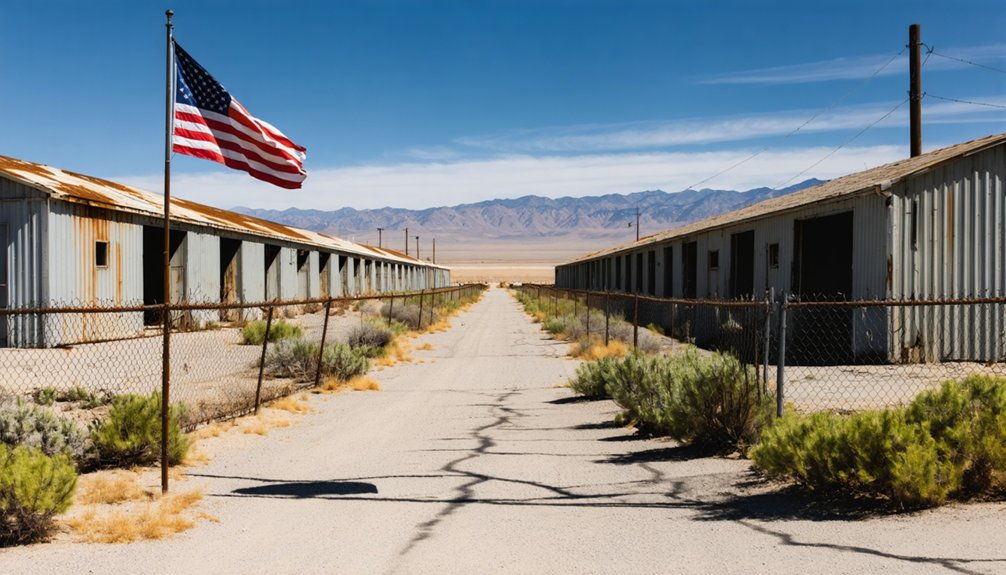
While the Cold War era demanded a vast network of military installations across America, the post-1980s period marked a fundamental shift toward infrastructure consolidation driven by strategic realignments and fiscal constraints.
When exploring these abandoned sites, you’re witnessing the physical aftermath of the Base Realignment and Closure (BRAC) commissions’ work—a process that shuttered over 350 installations across five major rounds (1988-2005).
These closures reflect America’s adaptation to evolving defense needs and technologies, particularly following the Soviet Union’s collapse.
The BRAC process, designed to insulate difficult decisions from political interference, generated annual savings exceeding $1.5 billion despite initial implementation costs of $4.1 billion.
For local communities, strategic realignment produced profound economic consequences—some regions suffered immediate job losses (approximately 70,000 positions eliminated), while others successfully converted military infrastructure into commercial enterprises or nature preserves.
Urban Exploration Challenges: Access and Safety at Military Ghost Towns
Despite their historical allure, abandoned military installations present urban explorers with a complex matrix of challenges that require careful planning and risk assessment.
When venturing into these forgotten fortresses, you’ll face significant legal implications and structural integrity concerns that can’t be ignored.
Navigating these ghost towns demands awareness of:
- Access restrictions – most sites remain under federal jurisdiction with trespassing penalties ranging from fines to criminal prosecution
- Structural hazards – decades of neglect create unstable floors, collapsed roofs, and compromised support systems
- Environmental dangers – asbestos, lead paint, and chemical contamination persist in these decaying structures
- Biological threats – wildlife infestations, mold growth, and accumulated animal waste harbor pathogens that pose serious health risks
The freedom to explore comes with responsibility—thorough research and proper equipment are non-negotiable prerequisites.
From Coast to Coast: Geographic Diversity of America’s Military Ruins
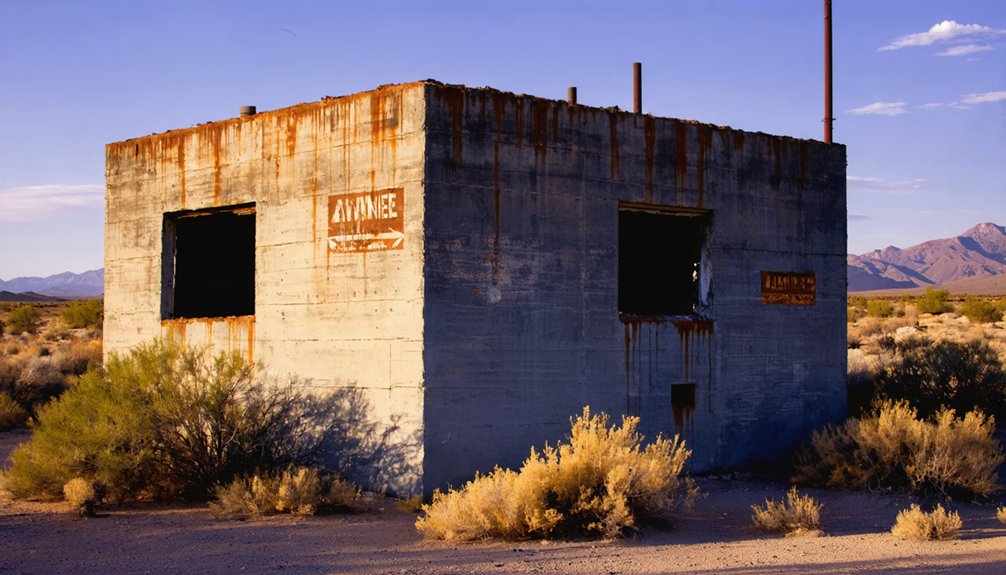
America’s military ruins exhibit distinct regional defense patterns that reflect historical strategic priorities, from California’s dense concentration of Cold War installations to the Eastern Seaboard’s mix of colonial and modern fortifications.
The geographical distribution reveals how climate conditions markedly impact structural deterioration, with southwestern bases facing accelerated decay from extreme heat while Great Lakes facilities battle freeze-thaw cycles.
You’ll notice that coastal defenses typically focused on naval threats and air superiority, while inland installations prioritized missile defense systems, training facilities, and logistics hubs—creating regionally-specific architectural and functional legacies.
Regional Defense Patterns
The geographic distribution of abandoned military installations across the United States reveals systematic defense planning paradigms that evolved throughout the twentieth century.
You’ll notice strategic consolidation patterns reflected in each region’s unique military footprint.
From your exploration, four distinct regional deployment strategies emerge:
- Northeast Corridor’s dense network leveraged urban infrastructure and industrial capacity
- Great Plains facilities utilized vast isolated spaces for weapons testing and training operations
- Pacific bases formed a strategic archipelago of forward operating positions against eastern threats
- Southern installations created an integrated defense complex maximizing desert terrain advantages
This regional significance isn’t accidental—it represents calculated positioning for national security requirements that adapted to changing geopolitical pressures.
The abandoned sites you’ll encounter tell the story of America’s evolving defense priorities through strategic placement and subsequent consolidation.
Climate Impact Variations
While exploring abandoned military installations across the country, you’ll encounter dramatic variations in climate-related environmental hazards that differ considerably by geographic region.
Arctic sites like Camp Century face melting ice that’s remobilizing PCBs and radioactive waste, while coastal installations from North Carolina to Guam struggle with intensifying hurricanes and rising seas.
You’ll find half of coastal bases experiencing 270+ flood events annually by 2050, with low-lying Pacific atolls particularly vulnerable to toxic waste dispersion.
Interior locations present different challenges—Fort Huachuca’s groundwater depletion threatens desert ecosystems while numerous Superfund sites leach contaminants into aquifers.
Environmental remediation efforts vary dramatically by location, with climate resilience strategies desperately needed as abandoned sites continue degrading under region-specific stresses that cross national boundaries and impact local communities.
Frequently Asked Questions
Are There Organized Legal Tours Available for Abandoned Military Bases?
You’ll find countless ghost town tours at decommissioned military facilities rather than active bases. Military base exploration is typically available through established museums, historic sites, and guided tours requiring advance registration.
How Do Surrounding Communities Adapt After Major Base Closures?
Communities leverage redevelopment plans to mitigate economic impact by diversifying industries, repurposing facilities, and securing federal assistance. You’ll find more successful adaptation in areas with strong leadership and realistic recovery strategies.
What Happens to Military Equipment Left Behind at Abandoned Bases?
Like a metal phoenix rising from abandoned nests, you’ll see military salvage operations claiming usable equipment, while hazardous materials undergo DEMIL procedures to minimize environmental impact through DLA’s regulated disposition services.
Can Photographers or Filmmakers Get Special Access Permissions?
You’ll need to navigate specific access guidelines by submitting formal permit requests, demonstrating professional credentials, liability insurance, and detailed creative project plans to managing authorities like the National Park Service or military departments.
Do Any Abandoned Bases House Classified Materials or Technologies?
Shrouded in secrecy yet decaying in plain sight, certain abandoned bases likely still house classified documents and secret technologies. You’ll find access severely restricted where sensitive materials remain, particularly in Cold War-era facilities.
References
- https://www.loveexploring.com/gallerylist/233478/americas-eeriest-abandoned-military-sites
- https://www.youtube.com/watch?v=9Xs418q7u9I
- https://www.prairiepast.com/blog/explore-3/fortuna-afb-85
- https://www.youtube.com/watch?v=Tl4FPjj0Otg
- https://www.youtube.com/watch?v=txuACj3SELs
- https://www.atlasobscura.com/lists/united-states-of-abandoned-places
- https://www.youtube.com/playlist?list=PLenYgd5YLQJ744EWXrjBFt-EtBj8FFdPo
- https://en.wikipedia.org/wiki/Roosevelt_Roads_Naval_Station
- https://ww2db.com/facility/Roosevelt_Roads_Naval_Base
- https://www.youtube.com/watch?v=uMD-vg01Sis

